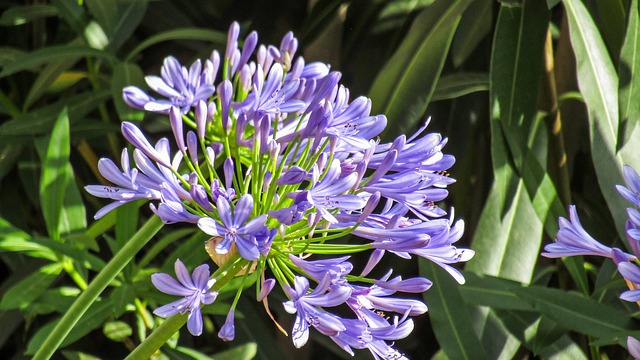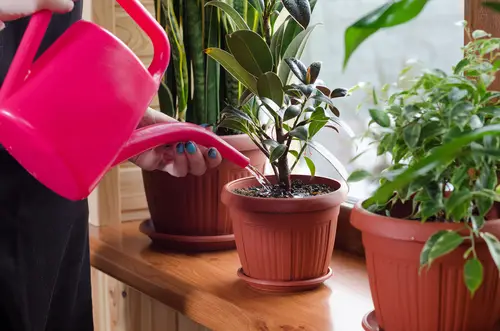Agapanthus is a beautiful flowering plant that can add a touch of elegance to any garden. However, if you notice that the leaves of your Agapanthus plant are turning yellow, it’s a sign that something is wrong.
There are several reasons why Agapanthus leaves may turn yellow, and it’s important to identify the cause so that you can take appropriate action. Understanding Agapanthus is the first step towards identifying why its leaves are turning yellow.
Agapanthus is a perennial plant that is native to South Africa. It is also known as the African lily and is prized for its beautiful blue or white flowers. Agapanthus plants are hardy and can grow in a variety of conditions, but they do require proper care to thrive.
Watering and drainage issues, pest and disease problems, nutrient deficiencies and soil conditions, and environmental factors are all potential causes of Agapanthus leaves turning yellow.
Each of these issues can be addressed with proper care and attention. By understanding the potential causes of yellowing leaves in Agapanthus plants, you can take steps to keep your plants healthy and vibrant.
Key Takeaways
- Agapanthus leaves turning yellow can be a sign of various issues, including watering and drainage issues, pest and disease problems, nutrient deficiencies and soil conditions, and environmental factors.
- Proper care and attention can address these issues and keep Agapanthus plants healthy and vibrant.
- By understanding the potential causes of yellowing leaves in Agapanthus plants, you can take appropriate action to ensure your plants thrive.
More posts on this category:
- Why Are My Sweet Peas Turning Yellow?
- Why Are My Tomatillo Leaves Turning Yellow?
- Why Are My Yucca Leaves Turning Yellow?
Understanding Agapanthus

Agapanthus, also known as Lily of the Nile, is a popular ornamental plant known for its striking blue or white flowers that bloom in summer. It is native to South Africa and belongs to the Amaryllidaceae family. Agapanthus plants can grow up to 2-4 feet tall and wide, and they prefer full sun to partial shade.
Agapanthus plants are relatively easy to care for, but they can be susceptible to various diseases and pests that can cause the leaves to turn yellow. Understanding the common causes of yellowing leaves can help you identify and address the problem promptly.
One of the most common reasons why agapanthus leaves turn yellow is due to overwatering. Agapanthus plants prefer well-drained soil, and excessive moisture can lead to root rot and other fungal diseases.
On the other hand, underwatering can also cause the leaves to turn yellow and dry out. It is essential to strike a balance and ensure that the soil is consistently moist but not waterlogged.
Another common cause of yellowing leaves is a lack of nutrients, particularly iron. Agapanthus plants prefer slightly acidic soil, and alkaline soil can cause iron deficiency, leading to yellowing leaves. Adding iron chelates or other iron-rich fertilizers can help address this problem.
Agapanthus plants can also be susceptible to various pests, including aphids, mealybugs, and spider mites, which can cause the leaves to turn yellow and wilt. Regular inspection and treatment with insecticidal soap or neem oil can help prevent and control pest infestations.
Finally, agapanthus plants can be sensitive to extreme temperatures and sunlight, which can cause the leaves to turn yellow and brown. Ensuring that the plants are adequately watered and shaded during hot and dry weather can help prevent sunscald and heat stress.
Watering and Drainage Issues
Agapanthus plants require regular watering to maintain their health and prevent yellowing leaves. However, overwatering or poor drainage can lead to waterlogged soil, which can cause root rot and other issues that can cause yellowing leaves.
In this section, we will discuss the most common watering and drainage issues that can cause agapanthus leaves to turn yellow.
Overwatering
Overwatering is one of the most common causes of yellowing leaves in agapanthus plants. When the soil is constantly wet, the roots cannot get enough oxygen, which can cause them to rot. This can lead to a buildup of harmful bacteria and fungi in the soil, which can further damage the roots and cause the leaves to turn yellow.
To avoid overwatering, it is important to water the plants only when the top inch of soil is dry. This will allow the roots to get enough oxygen and prevent the soil from becoming waterlogged. It is also important to make sure that the soil has proper drainage, as this will help excess water to drain away from the roots.
Waterlogged Pot

Another common cause of yellowing leaves in agapanthus plants is a waterlogged pot. When the pot does not have proper drainage, excess water can accumulate in the soil, which can cause the roots to rot. This can lead to a buildup of harmful bacteria and fungi in the soil, which can further damage the roots and cause the leaves to turn yellow.
To prevent a waterlogged pot, it is important to choose a pot with proper drainage holes. It is also important to make sure that the pot is not sitting in a saucer filled with water, as this can prevent excess water from draining away from the roots.
Proper Drainage
Proper drainage is essential for the health of agapanthus plants. When the soil has proper drainage, excess water can drain away from the roots, which can prevent root rot and other issues that can cause yellowing leaves.
To ensure proper drainage, it is important to choose a soil mix that is well-draining. This can be achieved by adding perlite, sand, or other materials to the soil mix. It is also important to make sure that the pot has proper drainage holes, as this will allow excess water to drain away from the roots.
Pest and Disease Problems
Agapanthus plants can be susceptible to a variety of pests and diseases, which can cause leaves to turn yellow. Being aware of the signs of common pests and diseases, as well as taking preventative measures, can help keep your agapanthus plants healthy and vibrant.
Common Pests
Agapanthus plants can be vulnerable to pests such as spider mites and mealybugs. Spider mites are tiny pests that feed on the sap of plants, causing leaves to turn yellow and dry out. Mealybugs, on the other hand, are small, white, cotton-like insects that feed on the sap of plants and can cause leaves to yellow and drop.
If you notice signs of a pest infestation, such as yellowing leaves or visible pests, it is important to act quickly to prevent further damage. Applying neem oil or using an insecticide can help control pest populations and prevent further damage to your agapanthus plants.
Fungal Diseases
Agapanthus plants can also be susceptible to fungal diseases such as leaf spot, root rot, anthracnose, gray mold, and powdery mildew. These diseases can cause leaves to turn yellow and drop, as well as affecting the overall health of the plant.
Fungal diseases can be prevented by ensuring that your agapanthus plants are planted in well-draining soil and are not overwatered. Additionally, applying a fungicide can help prevent the spread of fungal diseases and protect your plants from further damage.
Disease Prevention

Preventing pest and disease problems is key to keeping your agapanthus plants healthy and vibrant. To prevent pest infestations, it is important to keep your plants well-watered and fertilized, as healthy plants are less susceptible to pests.
Additionally, inspecting your plants regularly for signs of pests and acting quickly to control populations can help prevent further damage..
Nutrient Deficiencies and Soil Conditions
Agapanthus plants require a balanced diet of nutrients to maintain healthy foliage and blooms. Nutrient deficiencies and soil conditions can cause the leaves to turn yellow.
Iron Deficiency
Iron is an essential nutrient for agapanthus plants. Iron deficiency can cause yellowing of the leaves, starting from the tips and edges of the foliage. This condition is called chlorosis. Iron deficiency can occur in alkaline soil, where the pH level is above 7.0. The high pH level can make iron unavailable to the plant, even if it is present in the soil.
To prevent iron deficiency, gardeners can apply chelated iron to the soil. Chelated iron is a form of iron that is more readily available to the plant. Gardeners can also apply a fertilizer that contains iron.
Soil pH and Nutrient Absorption
Soil pH affects the absorption of nutrients by the plant. Agapanthus plants prefer slightly acidic soil with a pH level between 6.0 and 7.0. In alkaline soil, the availability of nutrients such as iron, copper, and zinc decreases. In acidic soil, the availability of nutrients such as phosphorus and potassium decreases.
To improve soil pH, gardeners can add organic matter such as compost, peat moss, or mulch to the soil. Organic matter can help lower the pH level of alkaline soil and increase the pH level of acidic soil. Gardeners can also apply a fertilizer that is specifically formulated for agapanthus plants.
Improving Soil Conditions
Agapanthus plants grow well in well-draining soil. In clay soil, the water tends to pool around the roots, causing the roots to rot. This can lead to yellowing of the leaves. To improve drainage, gardeners can add sand or perlite to the soil.
Gardeners can also improve soil conditions by adding organic matter such as compost, peat moss, or mulch to the soil. Organic matter can help retain moisture in sandy soil and improve drainage in clay soil.
In conclusion, nutrient deficiencies and soil conditions can cause yellowing of the leaves in agapanthus plants. Gardeners can prevent these conditions by applying a fertilizer that is specifically formulated for agapanthus plants, adding organic matter to the soil, and improving soil drainage.
Environmental Factors

When it comes to agapanthus leaves turning yellow, environmental factors can play a significant role. Understanding how environmental factors affect your plant can help you take preventive measures and keep your agapanthus healthy.
Sunburn and Temperature
Agapanthus plants thrive in full sun or partial shade. However, too much sun can cause sunburn, especially during the hottest days of summer. Sunburned leaves turn yellow and eventually die. Additionally, high temperatures can cause stress to your agapanthus, leading to yellowing leaves.
To prevent sunburn, make sure your agapanthus is planted in a location that receives the right amount of sun. If you notice sunburned leaves, move your plant to a shadier spot. You can also provide shade during the hottest part of the day by using a shade cloth or umbrella.
Frost Damage
Agapanthus plants are hardy and can tolerate some frost. However, when temperatures drop below freezing, your plant can suffer from frost damage. Frost-damaged leaves turn yellow and brown and eventually die.
To prevent frost damage, cover your agapanthus with a frost blanket or move it indoors if temperatures are expected to drop below freezing. If your plant has already suffered frost damage, remove the damaged leaves and wait for new growth to appear.
Air Circulation
Poor air circulation can also cause agapanthus leaves to turn yellow. When plants are crowded, air cannot circulate freely, leading to a buildup of moisture and increased risk of fungal diseases.
To improve air circulation, space your agapanthus plants at least 18 inches apart. If you are growing your plant indoors, make sure it is in a well-ventilated room. Additionally, avoid overwatering, as this can create a humid environment that fosters fungal diseases.
By understanding the environmental factors that can cause agapanthus leaves to turn yellow, you can take preventive measures to keep your plant healthy and thriving.
Proper Care for Healthy Agapanthus
Agapanthus plants are easy to grow and maintain as long as they receive the proper care. Here are some tips to keep your agapanthus healthy and prevent yellowing leaves.
1. Regular Pruning
Regular pruning is essential for the health of agapanthus plants. Prune the plants after flowering to remove dead flowers and stems. This will encourage new growth and prevent the plant from wasting energy on dead parts. Pruning also promotes air circulation, which reduces the risk of fungal diseases that can cause yellowing leaves.
2. Proper Fertilizing

Agapanthus plants need proper fertilization to maintain healthy growth and green pigment. Apply a balanced fertilizer, such as a 10-10-10 formula, in early spring before new growth appears.
Repeat the application every four to six weeks during the growing season. Avoid over-fertilizing, as this can lead to excess salt build-up in the soil and cause yellowing leaves.
3. Optimum Watering
Agapanthus plants require regular watering to maintain healthy growth and prevent reverse yellowing. Water the plants deeply once a week during the growing season.
Allow the soil to dry out slightly between watering to prevent overwatering, which can cause yellowing leaves. Use a well-draining soil mix and avoid planting agapanthus in pots with inadequate drainage holes.
Conclusion
Agapanthus leaves turning yellow can be a sign of various problems, such as nutrient deficiencies, overwatering, pest infestations, and fungal diseases. It is essential to identify the underlying cause and take appropriate measures to save the plant.
If the yellowing of leaves is due to nutrient deficiencies, it is recommended to fertilize the plant with a balanced fertilizer. However, if the yellowing is due to overwatering, it is necessary to discard the affected leaves and reduce watering frequency.
In case of fungal diseases, it is recommended to treat the plant with rubbing alcohol or a fungicide. For pest infestations, it is best to use insecticidal soap or neem oil to get rid of aphids or other pests.
It is important to note that potted Agapanthus plants require more water than those planted in the ground. However, overwatering can lead to bulb rot, which can cause yellowing of leaves and brown spots. Therefore, it is essential to maintain proper watering practices and ensure adequate drainage.
Frequently Asked Questions
What causes yellowing of agapanthus leaves?
Yellowing of agapanthus leaves can be caused by several factors. Overwatering, fungal diseases, nutrient deficiencies, pests, and extreme temperatures are some of the common reasons for yellowing of agapanthus leaves.
How do you treat agapanthus with yellow leaves?
Treating agapanthus with yellow leaves depends on the underlying cause. If the yellowing is due to overwatering, reduce the watering frequency and ensure proper drainage.
Fungal diseases can be treated with fungicides. Nutrient deficiencies can be corrected by adding appropriate fertilizers. Pests can be controlled with insecticides.
Can overwatering cause agapanthus leaves to turn yellow?
Yes, overwatering is one of the common causes of yellowing of agapanthus leaves. Overwatering can cause the roots to rot, leading to yellowing of leaves.
Why do agapanthus leaves turn yellow in winter?
Agapanthus plants are sensitive to cold temperatures, and their leaves can turn yellow in winter due to frost damage. In addition, the plant may go dormant during winter, and the leaves may naturally die back and turn yellow.
What are the signs of unhealthy agapanthus plants?
Unhealthy agapanthus plants may exhibit several signs, including yellowing of leaves, wilting, stunted growth, brown spots on leaves, and root rot. These signs may indicate fungal diseases, nutrient deficiencies, pests, or overwatering.
How can you prevent yellowing of agapanthus leaves?
Preventing yellowing of agapanthus leaves involves providing optimal growing conditions for the plant. This includes ensuring proper drainage, avoiding overwatering, providing adequate sunlight, and regular fertilization.
In addition, monitoring the plant for signs of pests and diseases and taking prompt action can help prevent yellowing of leaves.

Hey, I’m Lisa and I’ve been an avid gardener for over 30 years. I love writing, talking and living in the garden! Feel free to connect with me on my socials below


